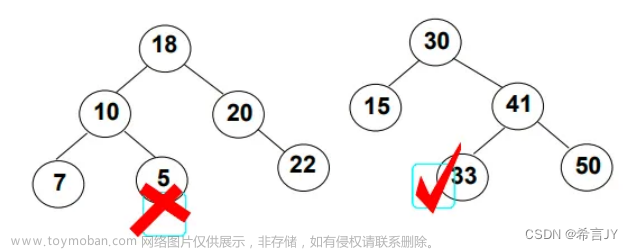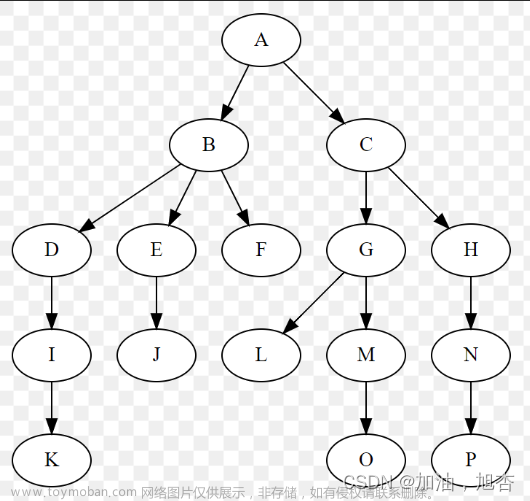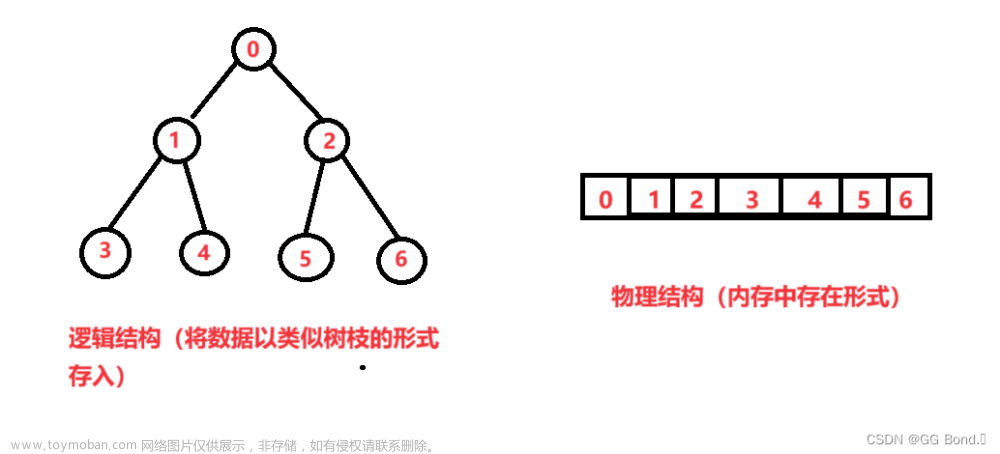二叉树定义
以下为本文解题代码的二叉树定义。
struct TreeNode {
int val;
TreeNode* left, *right;
TreeNode(int val = 0, TreeNode* left = nullptr, TreeNode* right = nullptr)
: val(val), left(left), right(right) {}
};
非递归后序遍历
题目描述
编写后序遍历二叉树的非递归算法。
解题代码
void nonRecurPost(TreeNode* root) {
if (root == nullptr) return;
stack<TreeNode*> s;
TreeNode* pre = nullptr;
while (root != nullptr || !s.empty()) {
while (root != nullptr) {
s.emplace(root);
root = root->left;
}
root = s.top();
s.pop();
if (root->right == nullptr || root->right == pre) {
cout << root->val << " ";
pre = root;
root = nullptr;
}
else {
s.emplace(root);
root = root->right;
}
}
}
反向层序遍历
题目描述
试给出二叉树的自下而上、从右到左的层序遍历算法。
解题代码
void reOrderTraversal(TreeNode* root) {
queue<TreeNode*> Q;
stack<int> S;
Q.emplace(root);
while (!Q.empty()) {
TreeNode* fNode = Q.front();
S.emplace(fNode->val);
Q.pop();
if (fNode->left != nullptr) {
Q.emplace(fNode->left);
}
if (fNode->right != nullptr) {
Q.emplace(fNode->right);
}
}
while (!S.empty()) {
cout << S.top() << " ";
S.pop();
}
}
非递归计算高度
题目描述
假设二叉树采用二叉链表存储结构,设计一个非递归算法求二叉树的高度。
解题代码
int nonRecurHeight(TreeNode* root) {
if (root == nullptr) return 0;
int res = 0;
queue<TreeNode*> q, nq;
q.emplace(root);
while (!q.empty()) {
while (!q.empty()) {
TreeNode* fNode = q.front();
q.pop();
if (fNode->left != nullptr) {
nq.emplace(fNode->left);
}
if (fNode->right != nullptr) {
nq.emplace(fNode->right);
}
}
q = move(nq);
++res;
}
return res;
}
根据中序和先序序列建立二叉树
题目描述
设一棵二叉树各结点的值互不相同,其先序遍历序列和中序遍历序列分别存储于两个一维数组 A 和 B 中,试编写算法建立该二叉树的二叉链表。
解题代码
TreeNode* recurCreate(vector<int>& preOrder, int l1, int r1, vector<int>& inOrder, int l2, int r2) {
if (l1 == r1) return nullptr;
auto preBegin = preOrder.begin() + l1, preEnd = preOrder.begin() + r1;
auto inBegin = inOrder.begin() + l2, inEnd = inOrder.begin() + r2;
int x = *preBegin;
TreeNode* root = new TreeNode(x);
auto it = find(inBegin, inEnd, x);
int lenL = it - inBegin;
root->left = recurCreate(preOrder, l1 + 1, l1 + lenL + 1, inOrder, l2, l2 + lenL);
root->right = recurCreate(preOrder, l1 + lenL + 1, r1, inOrder, l2 + lenL + 1, r2);
return root;
}
TreeNode* createTree(vector<int>& preOrder, vector<int>& inOrder) {
int l1 = 0, r1 = preOrder.size();
int l2 = 0, r2 = inOrder.size();
return recurCreate(preOrder, l1, r1, inOrder, l2, r2);
}
判断完全二叉树
题目描述
二叉树按二叉链表形式存储,试编写一个判别给定二叉树是否是完全二叉树的算法。
解题代码
bool isCompleteBT(TreeNode* root) {
queue<TreeNode*> Q;
Q.emplace(root);
bool isLeaves = false;
while (!Q.empty()) {
TreeNode* fNode = Q.front();
Q.pop();
if (fNode == nullptr) {
isLeaves = true;
continue;
}
if (isLeaves) return false;
Q.emplace(fNode->left);
Q.emplace(fNode->right);
}
return true;
}
计算双分支结点数
题目描述
假设二叉树采用二叉链表存储结构存储,试设计一个算法,计算一棵给定二叉树的所有双分支结点个数。
解题代码
int doubleNodeCnt(TreeNode* root) {
if (root == nullptr) return 0;
if (root->left != nullptr && root->right != nullptr) {
return 1 + doubleNodeCnt(root->left) + doubleNodeCnt(root->right);
}
else {
return doubleNodeCnt(root->left) + doubleNodeCnt(root->right);
}
}
交换左右子树
题目描述
设树 B 是一棵采用链式结构存储的二叉树,编写一个把树 B 中所有结点的左右子树进行交换的算法。
解题代码
void swapLRNode(TreeNode* root) {
if (root == nullptr) return;
TreeNode* temp = root->left;
root->left = root->right;
root->right = temp;
swapLRNode(root->left);
swapLRNode(root->right);
}
先序序列第k个结点值
题目描述
假设二叉树采用二叉链表存储结构,设计一个算法,求先序遍历序列中第 k (1 <= k <= 链表中结点个数)个结点的值。
解题代码
int kthNodeVal(TreeNode* root, int& k) {
if (root == nullptr) return 0;
if (--k == 0) return root->val;
return kthNodeVal(root->left, k) + kthNodeVal(root->right, k);
}
删除特定值的结点的子树
题目描述
已知二叉树以二叉链表形式存储,编写算法完成:对于树中的每个元素值为 x 的结点,删除以它为根的子树,并释放相应的空间。
解题代码
void freeMemory(TreeNode* root) {
if (root == nullptr) return;
freeMemory(root->left);
freeMemory(root->right);
delete root;
}
void deleteXNode(TreeNode* root, int x) {
if (root == nullptr) return;
else if (root->val == x) {
freeMemory(root);
return;
}
if (root->left != nullptr && root->left->val == x) {
freeMemory(root->left);
root->left = nullptr;
}
if (root->right != nullptr && root->right->val == x) {
freeMemory(root->right);
root->right = nullptr;
}
deleteXNode(root->left, x);
deleteXNode(root->right, x);
}
值为x的结点的祖先
题目描述
在二叉树中查找值为 x 的结点,试编写算法打印值为 x 的结点的所有祖先,假设值为 x 的结点的不多于一个。
解题代码
bool ancestorOfXNode(TreeNode* root, int x) {
if (root == nullptr) return false;
if (root->val == x) return true;
bool left = ancestorOfXNode(root->left, x);
bool right = ancestorOfXNode(root->right, x);
if (left || right) {
cout << root->val << " ";
}
return left || right;
}
两结点的最近公共祖先
题目描述
设 p 和 q 为指向二叉树中任意两个结点的指针,试编写算法找到 p 和 q 的最近公共祖先结点 r.
解题代码
TreeNode* lowestCommonAncestor(TreeNode* root, TreeNode* p, TreeNode* q) {
if (root == nullptr || root == p || root == q) return root;
TreeNode* left = lowestCommonAncestor(root->left, p, q);
TreeNode* right = lowestCommonAncestor(root->right, p, q);
if (left != nullptr && right != nullptr) {
return root;
}
else if (left != nullptr) {
return left;
}
else {
return right;
}
}
二叉树的宽度
题目描述
假设二叉树采用二叉链表存储结构,设计一个算法,求非空二叉树 b 的宽度(即具有结点数最多的那一层的结点个数)。
解题代码
int widthOfBT(TreeNode* root) {
if (root == nullptr) return 0;
size_t res = 1;
queue<TreeNode*> q, nq;
q.emplace(root);
while (!q.empty()) {
while (!q.empty()) {
TreeNode* fNode = q.front();
q.pop();
if (fNode->left != nullptr) {
nq.emplace(fNode->left);
}
if (fNode->right != nullptr) {
nq.emplace(fNode->right);
}
}
q = move(nq);
res = max(res, q.size());
}
return res;
}
满二叉树的后序序列
题目描述
设有一棵满二叉树(所有结点值均不同),已知其先序序列为 pre,设计一个算法求其后序序列 post.
解题代码
void getPost(vector<int>& preOrder, int p1, int q1, vector<int>& postOrder, int p2, int q2) {
if (p1 > q1) return;
postOrder[q2] = preOrder[p1];
int mid = (q1 - p1) / 2;
getPost(preOrder, p1 + 1, p1 + mid, postOrder, p2, p2 + mid - 1);
getPost(preOrder, p1 + mid + 1, q1, postOrder, p2 + mid, q2 - 1);
}
vector<int> postOfFBT(vector<int>& preOrder) {
int n = preOrder.size();
vector<int> res(n);
getPost(preOrder, 0, n - 1, res, 0, n - 1);
return res;
}
将叶结点连接为单链表
题目描述
设计一个算法将二叉树的叶结点按从左到右的顺序连成一个单链表,表头指针为 head,二叉树按照二叉链表形式存储。
解题代码
ListNode* linkingLeaves(TreeNode* root) {
queue<TreeNode*> q;
q.emplace(root);
ListNode* dummy = new ListNode(-1);
ListNode* curNode = dummy;
while (!q.empty()) {
TreeNode* fNode = q.front();
q.pop();
if (fNode->left == nullptr && fNode->right == nullptr) {
curNode->next = new ListNode(fNode->val);
curNode = curNode->next;
}
if (fNode->left != nullptr) {
q.emplace(fNode->left);
}
if (fNode->right != nullptr) {
q.emplace(fNode->right);
}
}
return dummy->next;
}
相似二叉树
题目描述
试设计判断两棵二叉树是否相似的算法。所谓二叉树 T1 和 T2 相似,指的是 T1 和 T2 都是空的二叉树或都只有一个根节点;或者 T1 的左子树和 T2 的左子树是相似的,且 T1 的右子树和 T2 的右子树是相似的。
解题代码
bool similarBT(TreeNode* root1, TreeNode * root2) {
if (root1 == nullptr && root2 == nullptr) return true;
if ((root1 == nullptr) ^ (root2 == nullptr)) return false;
if (root1->left == nullptr && root1->right == nullptr
&& root2->left == nullptr && root2->right == nullptr) {
return true;
}
return similarBT(root1->left, root2->left) && similarBT(root1->right, root2->right);
}
二叉树的带权路径长度和
题目描述
二叉树的带权路径长度(WPL)是二叉树中所有叶结点的带权路径长度之和,给定一棵二叉树,其叶结点的 val 域保存该结点的非负权值。设 root 为指向 T 的根节点的指针,设计求 T 的 WPL 的算法。
解题代码
BFS
int getWPL(TreeNode* root) {
queue<TreeNode*> q, nq;
q.emplace(root);
int res = 0;
for (int len = 0; !q.empty(); ++len) {
while (!q.empty()) {
TreeNode* fNode = q.front();
q.pop();
if (fNode->left == nullptr && fNode->right == nullptr) {
res += fNode->val * len;
}
if (fNode->left != nullptr) {
nq.emplace(fNode->left);
}
if (fNode->right != nullptr) {
nq.emplace(fNode->right);
}
}
q = move(nq);
}
return res;
}
DFS
int dfs(TreeNode* root, int depth) {
if (root == nullptr) return 0;
if (root->left == nullptr && root->right == nullptr) {
return root->val * depth;
}
return dfs(root->left, depth + 1) + dfs(root->right, depth + 1);
}
int getWPL(TreeNode* root) {
return dfs(root, 0);
}
表达式树转表达式
题目描述
请设计一个算法,将给定表达式树转换为对应的中缀表达式并输出。
解题代码
void dfs(TreeNode<char>* root, int depth) {
if (root == nullptr) return;
if (root->left == nullptr && root->right == nullptr) {
cout << root->val;
}
else {
if (depth > 1) cout << "(";
dfs(root->left, depth + 1);
cout << root->val;
dfs(root->right, depth + 1);
if (depth > 1) cout << ")";
}
}
void getInfixExp(TreeNode<char>* root) {
dfs(root, 1);
}
判定顺序存储二叉树是否为二叉搜索树
题目描述
已知非空二叉树 T 结点值均为正整数,采用顺序存储方式存储,T 中不存在的结点在数组中用 -1 表示。请设计一个尽可能高效的算法,判定一棵采用这种方式存储的二叉树是否为二叉搜索树。文章来源:https://www.toymoban.com/news/detail-703590.html
解题代码
bool dfs(vector<int>& T, int idx, int& lastVal) {
if (idx - 1 >= T.size() || T[idx - 1] == -1) return true;
if (!dfs(T, idx * 2, lastVal) || T[idx - 1] <= lastVal) return false;
lastVal = T[idx - 1];
return dfs(T, idx * 2 + 1, lastVal);
}
bool isBST(vector<int>& T) {
int lastVal = INT32_MIN;
return dfs(T, 1, lastVal);
}
根据层序序列建立二叉树
题目描述
设一棵二叉树层序遍历序列存储于一个一维数组中,空结点用 INT32_MAX 表示,试编写算法建立该二叉树的二叉链表。文章来源地址https://www.toymoban.com/news/detail-703590.html
解题代码
TreeNode* createTreeByOrder(vector<int>& order) {
if (order.front() == INT32_MAX) return nullptr;
queue<TreeNode*> q;
int idx = 0;
TreeNode* root = new TreeNode(order[idx++]);
q.emplace(root);
while (!q.empty()) {
TreeNode* fNode = q.front();
q.pop();
if (fNode == nullptr) continue;
if (idx < order.size()) {
TreeNode* lChild = nullptr;
if (order[idx] != INT32_MAX) {
lChild = new TreeNode(order[idx]);
}
fNode->left = lChild;
q.emplace(lChild);
++idx;
}
if (idx < order.size()) {
TreeNode* rChild = nullptr;
if (order[idx] != INT32_MAX) {
rChild = new TreeNode(order[idx]);
}
fNode->right = rChild;
q.emplace(rChild);
++idx;
}
}
return root;
}
到了这里,关于王道数据结构编程题 二叉树的文章就介绍完了。如果您还想了解更多内容,请在右上角搜索TOY模板网以前的文章或继续浏览下面的相关文章,希望大家以后多多支持TOY模板网!












